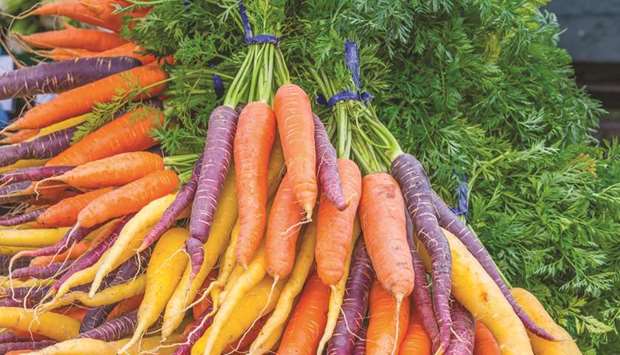How do you know when a carrot is dehydrated? Why should we care? I found the answer plus other interesting facts about my favourite vegetable in a recent article by registered dietitian Bethany Oxender in Food & Nutrition magazine, a publication of the Academy of Nutrition and Dietetics. I’ve highlighted a few here:
Carrots were not always harvested for their sweet, crunchy root – the part that we typically eat. In the olden days, carrots were grown for their pungent leaves and seeds which – by the way – are edible additions to soups, salads and other dishes.
Besides being one of the most popular vegetables in the US, carrots are also one of the most versatile. Eat ‘em raw, with skin or without, roasted, pureed, stewed or juiced. And don’t forget the secret trio of chopped carrots, celery and onions that top chefs use to enhance the flavour of soups and sauces. Yum.
Carrots are not always orange. They also come in white, purple, yellow and red hues. So what? Nutritionally, each of these colour pigments imparts a unique health benefit, say nutrition researchers. One more reason to dress up your vegetable selections with a variety of colours.
Don’t take carrots off the table if you’re counting carbs. Although sweet-tasting, these root vegetables are remarkably low in calories and carbs. According to the US Department of Agriculture, one medium carrot provides just 25 calories and 5 grams of carbohydrate, two of which are in the form of healthful dietary fibre. In fact, experts officially categorise carrots as nonstarchy vegetables along with the likes of broccoli, cabbage and other low calorie, high nutrient foods.
Nutritionally, carrots offer an excellent range of antioxidant/anti-inflammatory substances that enhance our health. Orange carrots are rich in beta-carotene, which the body converts to vitamin A, a major protector of eyesight. (You’ve never seen a rabbit wearing glasses, have you?) Purple, red and other colours of carrots contribute a variety of other antioxidant substances, each with its own health promoting benefits.
For people on special diets, such as a potassium restriction, carrots are a good choice. And they also get the green light as a low FODMAP food (I’ll explain what that is in a future column).
And did you know that those cute little baby carrots are not really baby carrots? They are regular carrots that have been cut into small sizes.
Finally, how do we know when a carrot is dehydrated? And why do we care? Apparently my favourite vegetable loses water and develops a white outer coating if it is allowed to languish in the fridge too long. Experts say these water-deprived carrots are safe to eat. Just revive them in a bath of clean ice water. – Tribune News Service

Carrots are not always orange. They also come in white, purple, yellow and red hues.


